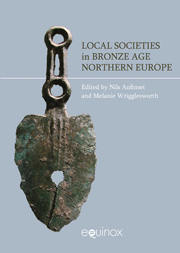Book contents
- Frontmatter
- Contents
- List of figures and tables
- Contributors
- Acknowledgements
- Introduction: local societies, regions and processes of cultural interaction in the Bronze Age
- PART I IDENTITY, GRAND NARRATIVES AND NETWORKS
- 1 Approaching a complex past: entangled collective identities
- 2 Asymmetric twins? Some reflections on coastal and inland societies in the Bothnian area during the Epineolithic and Early Metal Age
- 3 Expressing identity through ritual in the Early Bronze Age
- 4 Large-scale “grand narratives” and small-scale local studies in the Bronze Age discourse: the animal perspective
- 5 Reconsidering a periphery: scenarios of copper production in southern Norway
- 6 On the bronze trail: short-cuts, byways, transformation and displacement
- PART II REGIONS, GLOBALIZATION AND RESISTANCE
- Index
1 - Approaching a complex past: entangled collective identities
from PART I - IDENTITY, GRAND NARRATIVES AND NETWORKS
- Frontmatter
- Contents
- List of figures and tables
- Contributors
- Acknowledgements
- Introduction: local societies, regions and processes of cultural interaction in the Bronze Age
- PART I IDENTITY, GRAND NARRATIVES AND NETWORKS
- 1 Approaching a complex past: entangled collective identities
- 2 Asymmetric twins? Some reflections on coastal and inland societies in the Bothnian area during the Epineolithic and Early Metal Age
- 3 Expressing identity through ritual in the Early Bronze Age
- 4 Large-scale “grand narratives” and small-scale local studies in the Bronze Age discourse: the animal perspective
- 5 Reconsidering a periphery: scenarios of copper production in southern Norway
- 6 On the bronze trail: short-cuts, byways, transformation and displacement
- PART II REGIONS, GLOBALIZATION AND RESISTANCE
- Index
Summary
Introduction
In contemporary archaeology there is a general understanding that societies are not bounded homogeneous entities. In our theoretical arguments we emphasize heterogeneity, hybridity and creolization. It is, however, altogether less clear how we are to transfer this to actual interpretations of archaeological and perhaps especially prehistoric data. In the following I will present an attempt towards a more in-depth view of the complexity of collective identities in the Early Metal Age of northern Fennoscandia.
The heterogeneous society
The Sámi is an indigenous population in northern Fennoscandia, who were historically settled in larger parts of the interior of the Scandinavian Peninsula and throughout the northernmost parts of present-day Norway, Sweden, Finland and the Kola Peninsula in Russia (i.e. an even more extensive area than indicated in Figure 1.1). Although it is generally agreed today that most of the cultural elements that we recognize as specifically Sámi emerged in the centuries around year 0 (Hansen & Olsen 2004), there is strong cultural continuity back into the Stone Age. Despite long-term interaction with farming communities, these northern societies held on to their hunter–fisher lifestyle. Only during the second millennium ce did many Sámi groups begin nomadic reindeer herding, partly on a large scale. The Sámi speak a Fenno-Ugrian language (Sámi), contrary to the majority of the population in Norway and Sweden, who speak Germanic languages.
Many non-Sámi residents, particularly in southern parts of the Nordic countries, have regarded the Sámi as a rather homogeneous entity.
- Type
- Chapter
- Information
- Local Societies in Bronze Age Northern Europe , pp. 13 - 30Publisher: Acumen PublishingPrint publication year: 2012



